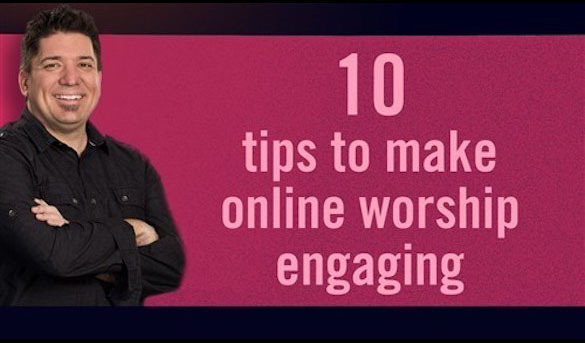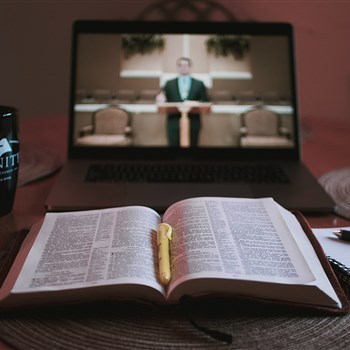
10 tips to make online worship engaging

Author and creative worship coach Jason Moore recently led an online workshop for Dakotas-Minnesota church leaders on navigating the new and unfamiliar world of fully online worship and church life. The full recording of the workshop is available, along with a handbook of useful resources and advice.
In case you don’t have time to watch the workshop or want a quick refresher, here are some takeaways that you can put into action in your own church context right away.
- Consolidate. “Think about making online worship shorter in length, but broader in scope,” said Moore. Instead of spending all your energy creating one elaborate hour-long experience together on Sunday, think about having a more condensed service that invites people to an online prayer time on Monday, a youth group meeting via Zoom on Tuesday, or some other midweek experience.
- Adapt. Find ways to make the service more interactive and participatory. For example, the pastor or worship leader can respond out loud in real time to comments in the live chat. Or people can text their prayer requests, and the pastor can pray for those requests right away. You have the opportunity to make people feel even more cared for and heard during the live stream service than when meeting in-person.
- Get closer to the camera. Avoid wide shots of the sanctuary. Make sure the speaker is well-lit and close to the camera and microphone. Look directly into the camera, not at your own image on the screen or at paper notes. If needed, you can get a teleprompter app (PromptSmart is voice-activated and keeps your pace) for your tablet and set it up next to the camera, or write your notes on a whiteboard just behind the camera.
- Hook viewers from the beginning. If you start your live-streamed service with a standard welcome and announcements, people will scroll past and find another stream to watch. Give them a return on investment (ROI) right away. Moore suggests starting by telling people what they will be able to learn and take with them after watching the service. Make announcements at the end, and frame them as action steps to live out the core message from the sermon.
- Think beyond the live stream. The people who feel the most isolated during this virus are often the ones who have the most challenges with technology. If the high-speed Internet connection at your church building is not great or if many of your members are not tech-savvy, find creative ways to offer access to worship. Consider pre-recording the worship service rather than live streaming to reduce lag. To supplement a live stream, give people a phone number they can call to listen to the worship service. Some churches offer a drive-in service in the parking lot using radio transmission. An even more low-tech option is to print and mail copies of the sermon and liturgy to people.
- Dream big. This is the time to try something new in worship. If there’s an idea you’ve wanted to try that you think members would be uncomfortable with, try it now. Nobody can say “we’ve never done it that way,” because we’ve never done anything the way we’re doing it right now.
- Practice social distancing. All worship leaders and musicians participating in the service need to be at least six feet away from each other. Don’t share a microphone, tablet, or hymnal while you are filming. Not only will this keep you safe, but it will help people watching from home focus on your message, rather than worrying about your health. It also models the behaviors everyone should be following to limit the spread of COVID-19.

- Connect with kids. Invite Sunday school teachers to mail letters to their students. Host an online scavenger hunt for youth with a pizza delivery as a prize. Record a video of someone telling a Bible story for kids each week. Send activity bags with coloring pages and puzzles to families.
- Update your website. Your website is the new front door of your church. Make sure your online worship times and the web address for the virtual service are more prominent than your physical address. Consider recording a short video with your pastor that welcomes first-time guests to the website and invites them to join the online worship service on Sunday, and place it prominently on the home page.
- Be ready for guests. Each week, assume someone is participating in your online worship for the first time. During the opening, always welcome guests. Have each person leading the service, including the pastor, introduce himself or herself. Consider that some visitors won’t be familiar with United Methodism or Christianity. Explain the parts of worship as you go, and assume not everyone knows words like doxology, prelude, and sacrament. Train some greeters to welcome and connect with new folks through the live stream chat.
Bonus tip: Pray! Before the worship service begins, pray with the worship leaders and musicians for everything from the microphone, to the live streaming platform, to being able to make meaningful connections with first-time visitors.
Blessings as you move into this new, uncertain, and potentially exciting time in the life of the church!